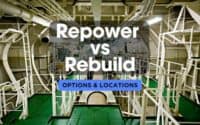The Top 7 Most Expensive Repairs

In the complex world of maritime operations, maintaining a ship over its lifetime involves addressing a variety of potentially expensive repairs. This article delves into the top seven categories of ship repairs that are likely to exceed $100,000 within the first 40 years of a vessel’s life. These repairs are essential not only for compliance with regulations but also for ensuring the safety, efficiency, and longevity of maritime operations.
* Please send feedback/suggestions to editor @ shipuniverse.com
#1 Engine and Machinery Overhaul or Replacement
Major Components
- Main Engine: The heart of most large vessels, main engines can range from medium-speed engines in smaller ships to massive low-speed engines in large cargo ships and tankers. The cost of a complete engine replacement depends on the engine’s power output and type but typically runs into several million dollars. For instance, a new main engine for a large container ship could cost anywhere from $2 to $5 million.
- Diesel Generators: These are crucial for providing electrical power for both operational functions and crew living conditions when the main engine does not run or as backup. The cost for replacing a marine diesel generator can range from a few hundred thousand dollars to over a million, depending on capacity and specifications.
- Propulsion Systems: This includes the components that translate engine power into movement, such as propellers, shafts, and rudders. Overhauling or replacing these can also be very expensive. For example, replacing a damaged propeller shaft or propeller can cost upwards of $500,000, depending on the size and material.
Overhaul Processes
- Overhauls are often scheduled during dry docking and involve complete disassembly, cleaning, inspection, repair, or replacement of worn or damaged parts. An engine overhaul can extend the engine’s life but typically costs about 20% to 50% of the cost of a new engine, still easily reaching the hundreds of thousands or more.
#2 Hull Repairs and Replacements
Types of Damage
- Collision and Grounding Damage: Collisions with other ships, docks, or grounding incidents can cause breaches or severe structural deformities in the hull. These repairs are urgent and can be incredibly complex, requiring extensive cutting, realignment, and welding.
- Corrosion: Ongoing exposure to harsh marine environments makes ships susceptible to corrosion, particularly in the ballast tanks and outer hull. Corrosion repairs might involve steel plate replacement, which requires cutting out the corroded sections and welding new steel plates.
Repair Processes
- Dry Docking: Ships must be taken out of service and placed in a dry dock for most types of hull repairs. This process itself incurs significant costs even before the actual repair work begins.
- Steelwork and Welding: Hull repair often involves significant steelwork. The cost of this work depends on the extent of damage and the price of materials and labor. In some cases, entire sections of the hull might need to be fabricated and replaced.
- Painting and Coatings: After structural repairs are complete, new coatings and marine paints are applied to protect against future corrosion. This process is labor-intensive and requires specialized materials.
#3 Navigation and Electronic Systems Upgrades
Components Involved
- Navigation Systems: This includes the electronic chart display and information system (ECDIS), global positioning systems (GPS), and automatic identification systems (AIS). These systems are essential for route planning, position tracking, and avoiding collisions. Upgrading these systems ensures compliance with international maritime regulations and enhances navigational safety.
- Radar Systems: Radar systems help detect other ships and navigational hazards, especially in poor visibility conditions. Modern radar systems offer improved detection capabilities and integration with other bridge systems for enhanced situational awareness.
- Communication Systems: This includes satellite communications (SATCOM), very high frequency (VHF) radios, and high frequency (HF) radios. These systems are crucial for distress signaling and day-to-day communications with shoreside operations and other ships. Upgrading to the latest technology ensures reliable communication, essential for safety and efficient operations.
Upgrade Processes
- Integration and Compatibility: Upgrading one component often requires adjustments to others to ensure system compatibility. For example, a new radar system may need to integrate with existing navigational displays and bridge systems.
- Regulatory Compliance: Navigation and communication equipment must meet specific standards set by international bodies like the International Maritime Organization (IMO). As these standards evolve, upgrades become necessary not just for enhanced functionality but also to comply with safety and operational regulations.
- Training and Implementation: New systems often require crew training. The cost of training can be significant, particularly if it involves simulator sessions or specialist courses.
#4 Gearbox and Propulsion System Repairs
Components and Common Issues
- Gearbox: The gearbox is a critical component that adjusts the output between the engine and the propulsion system. Issues might include bearing failures, gear wear, or lubrication problems. Gearboxes are complex mechanisms, and repairs can involve complete disassembly, machining of parts, or entire replacements.
- Shafts and Bearings: The propeller shaft transmits power from the gearbox to the propeller. Issues here can include misalignment, wear, or corrosion. Bearings, which support the shaft and allow it to rotate smoothly, can also wear out or fail.
- Propellers: Damage to propellers can occur due to impact with debris, grounding, or operational stress. Propeller repairs might involve physical repairs to blades, rebalancing, or even complete replacement if the damage is extensive.
Repair Processes
- Diagnostics and Disassembly: Identifying the exact cause of a failure often requires sophisticated diagnostic tools and disassembly of large, heavy components. This process is labor-intensive and requires specialized knowledge.
- Machining and Parts Replacement: Repairing or replacing parts like gears, bearings, or shafts often involves precise machining, which can be expensive. Custom parts may need to be manufactured, especially for older or unique ship models.
- Reassembly and Testing: After repairs, systems must be reassembled carefully and tested to ensure they operate correctly under load conditions. This testing is critical to ensure the ship can return to service safely.
#5 Environmental and Safety Equipment
Key Components
- Ballast Water Treatment Systems: These systems are critical for managing ballast water that ships take on and discharge to maintain stability and buoyancy. New international regulations require systems that prevent the spread of invasive species through ballast water. Upgrading to or installing new compliant systems can be a major expense, often reaching several hundred thousand dollars.
- Sewage Treatment Plants: Modern ships are equipped with advanced sewage treatment facilities that break down and sanitize waste before it is discharged into the ocean. Upgrading these systems to meet newer, stricter environmental standards ensures compliance and protects marine environments, but the cost can be significant.
- Fire Control Systems: This includes smoke detectors, fire alarms, sprinkler systems, and fire suppression systems designed to handle different types of fires (e.g., electrical, oil-based). Upgrading these systems for enhanced safety and compliance with the latest maritime safety regulations can be costly but is essential for the safety of the vessel and crew.
Upgrade and Replacement Processes
- Compliance with Regulations: Many of these upgrades are driven by new international regulations, such as those from the International Maritime Organization (IMO). Compliance requires not just hardware changes but also documentation and sometimes re-certification.
- Installation and Integration: Installing new systems or upgrading old ones often requires significant modifications to existing structures and systems, particularly for integrated operations with other ship systems.
- Testing and Commissioning: After installation, systems must be thoroughly tested and commissioned to ensure they operate as intended, which can involve specialists and potentially dry-docking the ship.
#6 Electrical System Overhaul
Key Components and Issues
- Wiring and Cabling: Over time, electrical wiring can deteriorate due to corrosion, vibration, and environmental exposure. Rewiring involves replacing old cables, which is labor-intensive and requires significant dismantling of ship interiors and structures.
- Distribution Panels: These panels control the distribution of electrical power across the ship. Upgrading these can involve replacing old panels and possibly reconfiguring the power distribution system to accommodate new technologies or increased capacity.
- Control Systems: Upgrades might include modernizing control systems that manage electrical loads and monitor electrical system health, which is crucial for avoiding power failures and ensuring efficient operation.
Overhaul Processes
- System Assessment and Planning: A comprehensive assessment to determine the extent of deterioration and the scope of necessary upgrades is the first step. This planning stage is critical to minimize operational disruptions.
- Execution of Rewiring and Installation: The actual work of rewiring is painstaking and requires the ship to be out of operational service. Specialized electrical technicians handle the installation of new wires, panels, and components.
- Safety Tests and Certification: Once the overhaul is completed, extensive testing is conducted to ensure all systems meet safety standards. The ship might also need to be recertified by a classification society to verify compliance with maritime electrical standards.
#7 Specialized Equipment Repairs
Types of Specialized Equipment
- Offshore Oil and Gas Exploration Equipment: This includes drilling rigs, dynamic positioning systems, and subsea production equipment. These systems are sophisticated and require high precision, making any repair or replacement particularly costly.
- Scientific Research Equipment: Oceanographic vessels may carry specialized labs, sonar mapping systems, and deep-sea submersibles. Repairs or upgrades to this equipment, due to the advanced technology involved and the necessity for high accuracy, can be exceedingly expensive.
- Renewable Energy Installations: For ships involved in installing or maintaining offshore wind turbines, specialized lifting and positioning equipment is crucial. These technologies are at the cutting edge of engineering, and repairing them can be as costly as their initial installation.
Repair and Replacement Processes
- Technical Expertise: Repairing specialized maritime equipment often requires expert technicians who possess specific skills and knowledge. This expertise comes at a premium, especially in niche areas like subsea technology or renewable energy installations.
- Parts and Logistics: Many components of specialized equipment are custom-made and not available off-the-shelf. Acquiring replacements can involve long lead times and significant costs, especially if they must be shipped to remote locations or require special handling.
- Testing and Recertification: After repairs, specialized equipment often needs to be thoroughly tested and possibly recertified to ensure it meets operational and safety standards. This process can be complex and costly, requiring additional equipment and specialist oversight.
Maintaining a ship over its first 40 years involves navigating through a series of high-cost repairs, each critical to the vessel’s operation and compliance with global maritime regulations. From engine overhauls to specialized equipment repairs, these maintenance activities represent significant financial investments, underscoring the importance of proactive management and maintenance planning in the maritime industry.

Do you have a Maritime Product or Service that may be of interest to Shipowners? Tell us about it here!
Do you have feedback or insights? Please reach out to editor @ shipuniverse.com



